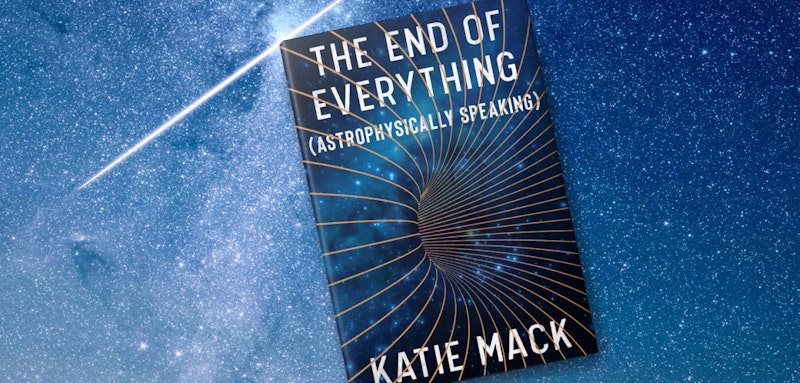Katie Mack, an astrophysicist at North Carolina State University and high-profile social-media science communicator, has written a book that feels oddly suitable for 2020, even though its subject is as distant from current events as can be. The End of Everything (Astrophysically Speaking), published by Scribner, is about scenarios presented by science for the universe’s ultimate fate, with names such as Heat Death, Big Crunch, Big Rip, and Vacuum Decay.
This litany of cosmic cataclysms presents an amusing diversion from current earthly troubles, and also invokes thought about what’s worth thinking about. In a recent interview at the online magazine Quanta, Mack was asked about studying the universe “even at a time when there are more urgent problems that require the attention of scientists.” Her answer reasonably noted that not all scientists can make their work relevant to a pandemic; and that scientific curiosity and other human aspirations can’t all be shut down because of crises.
The universe as we know it changed in 1998. Two competing groups of scientists had been collecting data on distant supernovae in an effort to pinpoint the rate of the slowdown of the universe’s expansion, a reduction expected in then-standard cosmology. Instead, the data showed the expansion was accelerating. That meant some little-understood factor was at work, which would become known as “dark energy.” It also indicated the far future would be bleak: the galaxies dispersing in a Heat Death or Big Chill that would end anyone or anything.
Physicist Freeman Dyson wrote a paper in 1979 sketching out how intelligent beings could survive indefinitely in an expanding, cooling universe, through adaptations such as repeated hibernations. An accelerating expansion, however, made even this survival strategy untenable. The 1998 discovery also meant the possibility of a Big Crunch—in which the expansion reverses into a contraction that ultimately ends the cosmos—could now essentially be dismissed.
A Heat Death seems to condemn the universe to an eternity of cold nothingness. However, Mack notes, it also raises some strange possibilities. One is that, given unlimited time to occur, there might be a random fluctuation that returns the universe to a previous state. This could mean that Nietzsche’s “eternal return” of events that have already happened is real. Alternatively, since a fluctuation that reproduces a small part of the universe is more likely than one that reproduces a larger one, there may exist “Boltzmann brains,” entities that incorrectly perceive an ordered universe around them when in fact they float in chaos.
It’s also possible there won’t be a Heat Death, because a different universe-ending scenario occurs first. One would be a Big Rip, which would transpire if the relationship between dark energy’s density and pressure is even slightly different from the cosmological constant that physicists have assumed. In this scenario, celestial objects would come apart, the Earth would explode, and finally the fabric of space would disintegrate. However, calculations indicate this scenario can’t happen until at least 188 billion years from now.
By contrast, Vacuum Decay is a cosmos-destroying scenario that’s not necessarily relegated to the distant future. In this picture, the Higgs energy field that pervades all space turns out less stable than hoped, such that what we regard as vacuum is in fact “false vacuum.” In that case, a disruption anywhere in the universe could generate an expansive bubble of true vacuum, or as Mack puts it “a quantum bubble of death.” This could occur anytime.
What might cause a Vacuum Decay event? In the past couple of decades, there have been claims that particle accelerator experiments could provide the disruptive trigger. Physicists have dismissed such concerns on the grounds that natural phenomena—cosmic rays hitting the moon, for example—generate extremely high energies without causing vacuum instability. Of course, some even-higher energy produced naturally or artificially might someday do the trick.
This brings up a funny memory. Two decades ago, I was working at Lou Dobbs’ Internet start-up Space.com when we ran a news story reporting physicists’ skepticism about concerns that a collider at the Brookhaven Lab on Long Island posed a vacuum risk. The wiseacre headline was something like “Brookhaven Probably Won’t Destroy Universe.” Lou was incensed, issuing red-faced harangues to staffers. He didn’t want the website downplaying a potentially high-traffic controversy. It was an early sign that Dobbs was not the avuncular guy familiar from television.
While the above scenarios put an emphasis on doom, Mack presents one more, Bounce, that offers a degree of cosmic hope. This involves a new universe emerging from the old. Some cosmological models, including ones called “ekpyrotic,” from the Greek for “conflagration,” provide such cyclic potential; for instance, cosmologists Anna Ijjas and Paul Steinhardt propose to explain features of the early universe as arising from a small patch of a prior universe. Conceivably, gravitational waves carry information from one universe to the next.
The End of Everything is a thought-provoking, entertaining and unexpectedly cheering book.
—Kenneth Silber is author of In DeWitt’s Footsteps: Seeing History on the Erie Canal and is on Twitter: @kennethsilber

